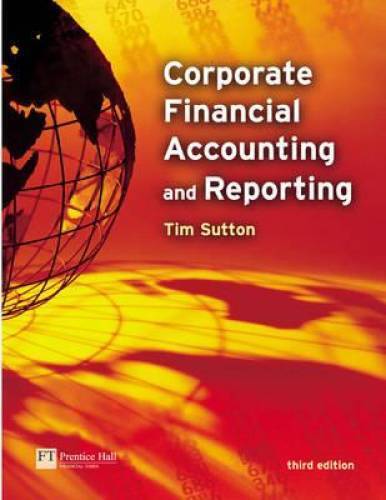Accounting for financial investments under new IAS: basic framework Chisme Company makes certain investments in debt and
Question:
Accounting for financial investments under new IAS: basic framework Chisme Company makes certain investments in debt and equity securities at the start of year 4. The acquisition cost of the investments and their end-year 4 market values are set out below. (Amounts are in A000.)
Acquisition End-year 4 cost market value Dingsda AG, 30,000 ordinary shares 750 570 Thingummy plc, 20,000 ordinary shares 680 700 Truc SA, 1,500 8% preference shares 120 not available Coso SpA, 6% bonds, due end-year 7 356.1 360 The Thingummy shares Chisme holds are a held-for-trading investment; the Dingsda shares are an available-for-sale investment. As for the Truc investment, the (non-redeemable) preference shares are accounted for at cost as they are unquoted and their end-year 4 market value cannot be determined reliably. Chisme plans to hold the Coso bonds to maturity and therefore accounts for them at amortised cost. The bonds have a face value of A350,000 and pay interest annually. The effective interest rate at the date of purchase was 5.5%.
None of the companies in which Chisme holds shares pays a dividend in year 4.
Required Show the effect of the following events on Chisme’s year 4 accounts:
(a) purchase of the four investments at the start of the year;
(b) accrual and receipt of interest during the year;
(c) fair value adjustments at year-end.
Use journal entries or the balance sheet equation.
Check figure:
Total carrying amount of investments, end-year 4 (in A000) A1,744.7 418 PART 2 • THE HOUSE OF ACCOUNTING CHAPTER 13 • FINANCIAL INVESTMENTS 419 P.13.3 Accounting for financial investments under new IAS: extensions Chisme Company (see P13.2) makes certain changes to its investment portfolio in year 5. These changes – and the end-year 5 fair values of its investments – are set out below.
1 Chisme sells half of its Thingummy shares for A355,000 in May year 5. The market value of the remaining shares is A33/share at the end of year 5.
2 Dingsda experiences financial problems in year 5. At year-end, the market value of the shares is only A10/share. Chisme’s management consider the investment impaired and decide to recognise the loss in income that year.
3 After a review of the company’s investments at end-year 5, Chisme’s management decide to reclassify the Coso bonds as an available-for-sale investment as they no longer plan to hold them to maturity. The fair value of the bonds then is A363,200.
4 As a result of an overhaul of its business by new management, Truc makes profits in year 5 and resumes paying a dividend (of A8/share) on its preference shares. (The preference dividend is not cumulative.) Although the company is unquoted, Chisme’s management use cash-flow-based valuation techniques to value the investment. They estimate its end-year 5 value at A160,000 and classify Truc as an available-for-sale investment.
Required Show the effect on Chisme’s year 5 accounts of the following events:
(a) Accrual and receipt of interest (on Coso bonds) and receipt of dividend (on Truc’s preference shares) during the year. Neither Dingsda nor Thingummy pays a dividend in year 5.
(b) Sale of Thingummy shares in May.
(c) Recognition of impairment of Dingsda investment at year-end.
(d) Transfer of Coso bonds to AFS category at year-end.
(e) Fair value accounting of Truc shares and fair value adjustment of other investments at year-end.
Use journal entries or the balance sheet equation.
AppenedixLO1
Step by Step Answer:






